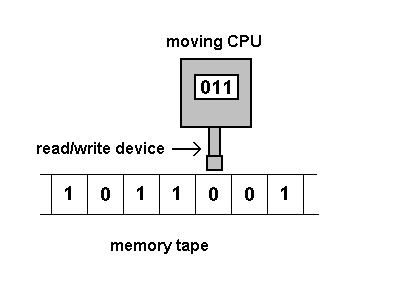Turing machines
From 2009.igem.org
(Difference between revisions)
Samitwatve (Talk | contribs) |
|||
| (19 intermediate revisions not shown) | |||
| Line 1: | Line 1: | ||
| - | { | + | {{Team:IBB_Pune/header}} |
| + | {{team:IBB_Pune/menu}} | ||
| + | <html> | ||
| + | <body bgcolor="blue"> | ||
| + | </html><br> | ||
| + | <p><span style="font-weight:bold; font-size:200%; color:#0000cc;">Turing Machines</span></p><br> | ||
| - | + | <html> | |
| - | + | <p><p>Turing machines form an extremely exciting part of mathematics, yes; they are a piece of mathematics(!) which are elegant, simple and powerful. They form the basis of computer programming. They help us understand the nature of algorithms and how the mind works. | |
| - | + | ||
| - | + | ||
| - | + | ||
| - | + | ||
| - | + | ||
| - | + | ||
| - | + | ||
| - | + | ||
| - | + | ||
| - | + | ||
| - | Turing machines form an extremely exciting part of mathematics, yes; they are a piece of mathematics(!) which are elegant, simple and powerful. They form the basis of computer programming. They help us understand the nature of algorithms and how the mind works. | + | |
Let us first try to see what a Turing machine actually is. | Let us first try to see what a Turing machine actually is. | ||
| - | The scientist and brilliant mathematician Alan Turing came up with this idea in an attempt to solve a problem in mathematics known as ''Entscheidungsproblem''. It translates to "a decision problem", and it was put forward by the German mathematician David Hilbert. Hilbert’s problem was- is there any general algorithmic procedure for resolving mathematical questions or whether in principle such a procedure might exist?. | + | The scientist and brilliant mathematician Alan Turing came up with this idea in an attempt to solve a problem in mathematics known as ''Entscheidungsproblem''. It translates to "a decision problem", and it was put forward by the German mathematician David Hilbert. Hilbert’s problem was- is there any general algorithmic procedure for resolving mathematical questions or whether in principle such a procedure might exist?.</p></p></body> |
| - | + | </html> | |
| - | Turing’s concept: | + | <p><span style="font-weight:bold; font-size:150%; color:#FF6600;">Turing’s concept:</span></p> |
| + | |||
| - | [[Image:Turing.jpg|center]] | + | [[Image:Turing.jpg|center|thumbnail|500px]] |
| Line 28: | Line 23: | ||
It can move the tape towards the right or left, allowing it to ‘read’ further marks on the tape. | It can move the tape towards the right or left, allowing it to ‘read’ further marks on the tape. | ||
| - | + | [[Image:tape4.png|center|500px|thumbnail]] | |
| - | | | + | |
| - | + | ||
| - | + | ||
| - | + | ||
| - | + | ||
| - | + | ||
| - | + | ||
| - | + | ||
| - | + | ||
| - | + | ||
| - | + | ||
| - | + | ||
| - | + | ||
| - | + | ||
| - | + | ||
| - | + | ||
| - | + | ||
| - | + | ||
| - | + | ||
| - | + | ||
| - | + | ||
| - | |||
| - | |||
| Line 64: | Line 36: | ||
If you are wondering, "HOW??" | If you are wondering, "HOW??" | ||
<html> | <html> | ||
| - | <p><a href="https://2009.igem.org/ | + | <p><a href="https://2009.igem.org/Small_two-state"> <span style="font-weight:bold; font-size:125%; color:#0000cc;">Click Here</span></a></p> |
</html> | </html> | ||
| - | + | <p><span style="font-weight:bold; font-size:125%; color:#FF6600;">References</span></p> | |
| - | + | ||
1. http://en.wikipedia.org/wiki/Turing_machine | 1. http://en.wikipedia.org/wiki/Turing_machine | ||
| Line 77: | Line 48: | ||
4. "The Emperor's New Mind", 2nd Edition, Roger Penrose, Martin Gardner (1999), Oxford University Press | 4. "The Emperor's New Mind", 2nd Edition, Roger Penrose, Martin Gardner (1999), Oxford University Press | ||
| - | |||
| - | |||
| - | |||
| - | |||
Latest revision as of 02:35, 22 October 2009

 "
"

